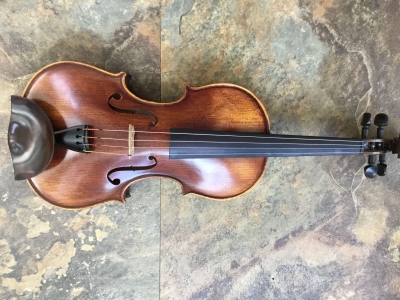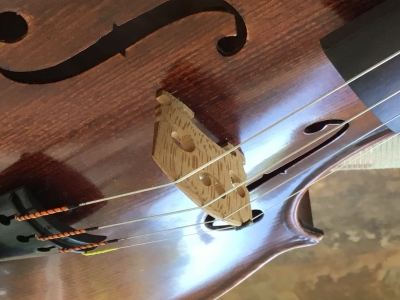Welcome to our forum. A Message To Our New and Prospective Members . Check out our Forum Rules. Lets keep this forum an enjoyable place to visit.
Currently working on errors from the latest (SimplePress) forum update. Many issues have been resoled and others are being worked on. Thank you for your patience.
 Topic RSS
Topic RSS



 (0 votes)
(0 votes) Regulars
 Offline
Offline

Hi all. An update on the MV500 (and some photos). It is now sporting a set of Knilling perfection pegs and an ebony 3/4 size tailpiece. The G, D, and A strings are from a set of Opera (chinese) perlon viola strings. The E string is a standard violin Optima Goldbrokat Medium (#26). I roasted the Cecilio bridges that came with it and slightly altered the radius to lower the string heights and, of course, its thickness.
The MV500 does not have the power of the MV650 and I think, in general, that I like the MV650 more. But I must say that the MV500 is an extremely attractive violin and has a very rich set of harmonics (perhaps from the 3/4 sized tailpiece). I am going to modify the chin rest so that I can integrate it with the Wittner Isny shoulder rest components that I got from Wittner. I got this second hand, but I doubt that it had been played. I think that a high school student would be very happy with it and the sound would blend well with other strings in an orchestra.
 _
_
 _
_
Success is the progressive realisation of a worthy ideal. —Earl Nightingale.
Regulars
 Offline
Offline

Hi Fiddlerman (and others).
First, regarding the picture of the bridge. The image somehow got re-orientated when transmitted to the page and it gives me a sort of vertigo when looking at it. Sorry about that but I don't know how to correct it.
I am using the same bridge that came with the MV 500 (which was installed when I received it with the name toward the fingerboard). I roasted it, trimmed it to reflect proper string heights (the feet were very well configured to the front plate as received, so I did not mess with that), and substantially reduced the depth of the wood though providing a substantial "belly" for strength. The sound was much improved from the original although the G string has slightly less punch than the other strings. I was going to move the sound post more toward the "E" string foot to improve this, and perhaps expand the bass side bridge "heart" if I still feel a need to do something.
But I think that the big improvement was going from the 4/4 tailpiece to the 3/4 tailpiece. That really expanded the lower harmonic component of the sound. I have read that this effect is increased by removing the tail piece side string "whippings." I am wondering if I can burn them off with an alcohol lamp, but I am concerned that I might damage the perlon. The metal winding might protect the perlon from the heat for the few seconds it would take to remove the "whipping," but I am not sure.
If you have a rogue instrument with a very bright (to harsh) voice (or would like a violin that would blend extremely well with a string quartet), you might want to try reducing the size of the tail piece to 3/4. As I write this, I wonder how this modification would sound on an electric violin or a cello?
A last comment. The Mendini MV 500 was the only Cecilio branded violin I have ever owned that came with an honest threaded nylon tail piece gut loop. All of the others that I have seen came with a crimped piece of insulated wire.
Success is the progressive realisation of a worthy ideal. —Earl Nightingale.
Regulars
 Offline
Offline

Hi Fiddlerman (and others). I measured 2.552 inches between the bridge and the string ridge of the 3/4 tailpiece on the MV 500. As a comparison, I measured 1.951 inches between the same two points on the MV 650, which has a conventional 4/4 tailpiece.
I have been playing the MV 500 for several days now and the G string is now equal in volume to the other strings. I don't know if the string is breaking in or I am making the adjustment in bowing pressure.
Success is the progressive realisation of a worthy ideal. —Earl Nightingale.


 Log In
Log In Register
Register

























